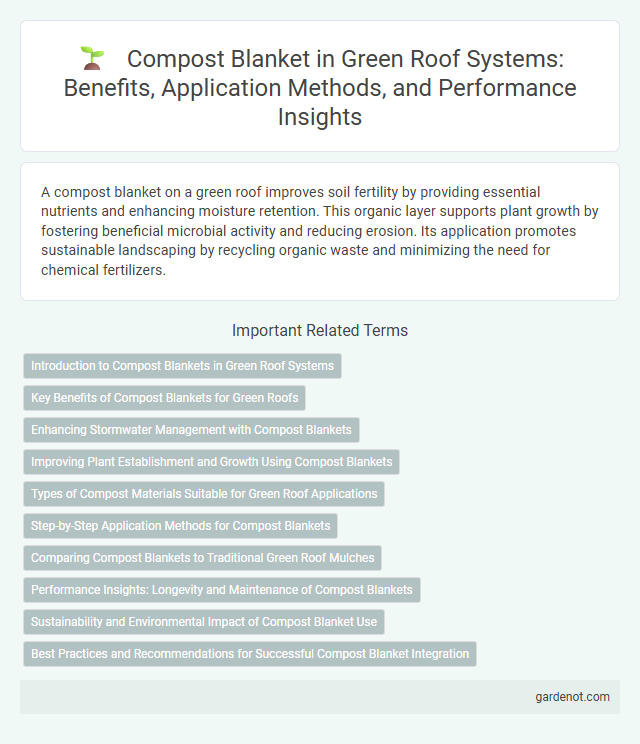A compost blanket on a green roof improves soil fertility by providing essential nutrients and enhancing moisture retention. This organic layer supports plant growth by fostering beneficial microbial activity and reducing erosion. Its application promotes sustainable landscaping by recycling organic waste and minimizing the need for chemical fertilizers.
Introduction to Compost Blankets in Green Roof Systems
Compost blankets in green roof systems enhance substrate fertility and moisture retention by providing a nutrient-rich organic layer directly above the growing medium. This biodegradable layer supports plant establishment and promotes beneficial microbial activity, improving the overall health and sustainability of the green roof ecosystem. Proper application thickness and quality of compost materials are critical for optimizing plant growth and minimizing erosion on sloped green roof surfaces.
Key Benefits of Compost Blankets for Green Roofs
Compost blankets improve green roof performance by enhancing soil moisture retention and promoting healthy root development, which reduces irrigation needs and extends plant life. They contribute to nutrient cycling and organic matter enrichment, supporting robust plant growth and biodiversity. Furthermore, compost blankets act as natural insulation, moderating roof temperature fluctuations and increasing energy efficiency.
Enhancing Stormwater Management with Compost Blankets
Compost blankets significantly improve stormwater management by increasing soil infiltration and reducing surface runoff through their high organic matter content. Their porous structure enhances water retention and promotes microbial activity, which supports soil stability and filtration of pollutants. Implementing compost blankets on green roofs effectively mitigates flooding risks while improving water quality in urban environments.
Improving Plant Establishment and Growth Using Compost Blankets
Compost blankets enhance plant establishment and growth by providing a nutrient-rich layer that improves soil moisture retention and supports microbial activity. This organic cover protects seedlings from erosion and temperature fluctuations, promoting healthier root development and faster vegetation establishment. Employing compost blankets on green roofs accelerates plant colonization and improves overall ecosystem resilience.
Types of Compost Materials Suitable for Green Roof Applications
Compost blankets for green roof applications typically utilize organic materials such as shredded leaves, grass clippings, and food waste due to their high nutrient content and moisture retention capabilities. Woody compost, including shredded bark and wood chips, provides enhanced aeration and structural support, promoting healthy root growth. Selecting well-decomposed, pathogen-free compost ensures optimal plant health and longevity of green roof systems.
Step-by-Step Application Methods for Compost Blankets
Compost blanket application on green roofs involves evenly spreading a 2-4 inch layer of mature compost over the substrate to enhance soil fertility and support vegetation growth. Use hand tools or mechanical spreaders to achieve uniform coverage, ensuring the compost layer conforms to roof slopes without erosion or displacement. Regular moisture monitoring and gentle compaction help maintain the compost's effectiveness as a nutrient-rich, erosion-control medium in green roof systems.
Comparing Compost Blankets to Traditional Green Roof Mulches
Compost blankets outperform traditional green roof mulches by enhancing water retention and nutrient availability, which supports stronger plant growth and increased biodiversity. Their organic matter composition improves soil structure and microbial activity, leading to better stormwater management and extended roof longevity. Unlike conventional mulches, compost blankets contribute to carbon sequestration and reduce the need for synthetic fertilizers, promoting sustainable urban ecosystems.
Performance Insights: Longevity and Maintenance of Compost Blankets
Compost blankets significantly enhance green roof performance by improving moisture retention and nutrient availability, contributing to prolonged substrate health and plant vitality. Their organic composition fosters microbial activity that supports soil structure and reduces erosion, extending the roof system's lifespan. Maintenance is minimal but essential, with periodic replenishment recommended every 3-5 years to sustain optimal compost function and ensure long-term ecological benefits.
Sustainability and Environmental Impact of Compost Blanket Use
Compost blankets enhance sustainability by improving soil health through organic matter enrichment and moisture retention, reducing the need for synthetic fertilizers and irrigation. Their use promotes biodiversity by providing a habitat for beneficial microorganisms that support plant growth and carbon sequestration. Implementing compost blankets on green roofs significantly mitigates urban heat island effects and manages stormwater runoff, contributing to improved environmental resilience.
Best Practices and Recommendations for Successful Compost Blanket Integration
A successful compost blanket integration in green roofs requires selecting high-quality, mature compost with a balanced carbon-to-nitrogen ratio to enhance soil fertility and moisture retention. Proper application involves evenly spreading a 2-4 inch layer over the substrate to promote vegetation establishment and prevent soil erosion, while avoiding overly thick layers that could hinder plant root aeration. Regular monitoring of nutrient levels and moisture content is essential to maintain optimal conditions for plant growth and ensure the long-term sustainability of the green roof ecosystem.
Compost blanket Infographic

 gardenot.com
gardenot.com